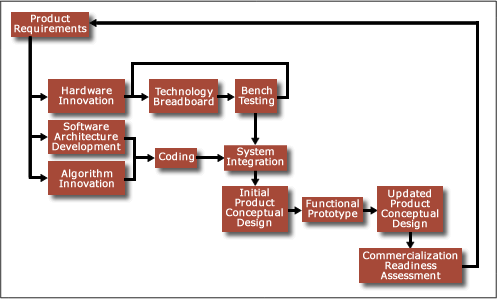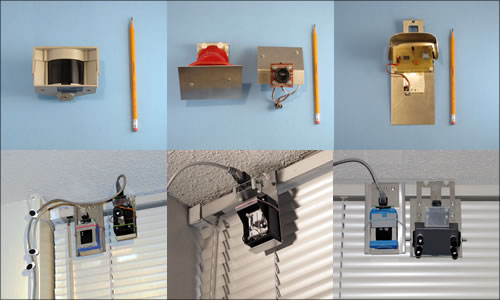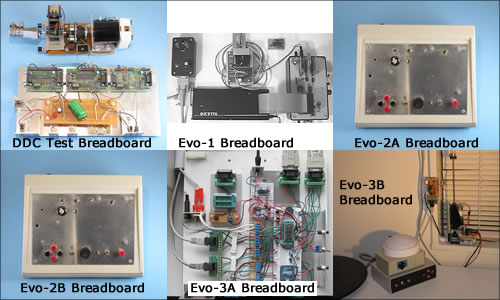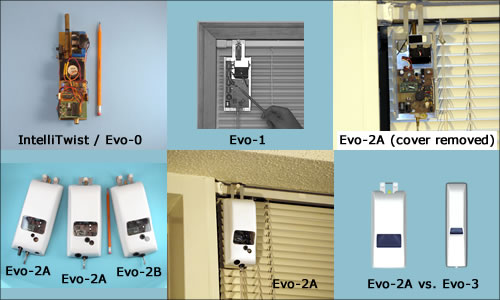Research and Development
Iterative R&D Process
The IntelliBlinds™ Model D miniblind actuator was developed via an iterative R&D process, with each iteration including basic technology development as well as product prototyping:

The overall IntelliBlinds™ product configuration has gone through three major iterations, with dozens of iterations in developing the individual technology components and design features.
Each major iteration was preceded by market research to establish or refine a set of market-driven product requirements which defined the objectives for that iteration's development efforts, and followed by a commercialization readiness assessment to determine what, if any, further development would be needed.
Technology Development
IntelliBlind's key technologies are in the areas of sensors, user interfaces, electromechanics, and control algorithms. Each R&D iteration was triggered by an idea for innovation in one or more of these key technology areas. For example, the initial R&D interation was triggered by ideas which eventually led to the patented IntelliDapter™ and IntelliTwist™ technologies.
Hardware Innovation
Each hardware technology innovation was first implemented via a technology breadboard to facilitate evaluation and refinement. Numerous technology breadboards were developed for each of the component hardware technologies, particularly the IntelliLux™ DayLight Sensor (DLS).

Software Architecture Development
For each R&D iteration, the user interface ("look and feel"), functions, and modes defined in the product requirements were translated into a software architecture that served as the framework for the IntelliBlinds™ software development.
Algorithm Innovation
Many of the IntelliBlinds™ advantages are due to a synergistic combination of innovative algorithms and hardware. For example, the IntelliBlinds™ Model D includes an innovative feedback control algorithm for DDC operation, as well as the IntelliState™ automation algorithm that learns users' shading preferences. As might be expected, these algorithms went through dozens of evolutions over the course of each R&D iteration.
Coding
The IntelliBlinds™ software was developed in the Visual Basic-like langauge used by the microcontroller development system selected for the prototypes. Fully documented, the software could be easily ported to other microcontroller families as required.
Prototyping
In the first step of each product prototyping iteration, the technology breadboards were interconnected to form a functional system on the lab bench. This involved development of a system breadboard, which contained the microcontroller running the software for the overall system as well as interfaces to the various technology components.

After integration, each system breadboard was used to test the performance of the system in the lab as well as in a representative office environment.
Once the testing of the system breadboard verified that the performance requirements had been met, the next step was to develop and test the IntelliBlinds™ product prototype itself. This involved four steps:
- Developing a conceptual design of a production IntelliBlinds™ product, with consideration given to aesthetics, producibility, and usability.
- Packaging the various system components into a self-contained functional prototype having the general configuration, form factor, user interface, and performance capabilities of the conceptual production design.
- Testing the functional prototype in the lab and in a representative environment. This included instrumented performance testing of the DDC capability with varying window orientations and room geometries, and in varying weather conditions and seasons
- Testing the prototype in focus groups to gauge potential user acceptance.

Production Unit Conceptual Design
After each IntelliBlinds™ functional prototype was successfully tested, it was redesigned on paper for volume production and market entry. The purpose of this production unit conceptual design was to serve as a basis for cost and performance projections to support commercialization readiness assessments.
Factors considered in development of each production unit concept included:
- Minimization of net end-user cost (including product price, distribution costs, and installation labor)
- Producibility (including amenability to contract manufacturing)
- Parts sourcing
- "Look and feel"
While the production concepts were not intended for actual production, the current conceptual design could, indeed, serve as the basis for a production design, and we believe it represents a near-optimum balance between cost and capability for maximum market penetration.
Currently, the Production Unit Conceptual Design consists of a product specification, mechanical drawings, and Bill of Materials for key parts. The major steps required to further develop the design for actual production would be preparation of the final schematic and PCB layout and design of the production tooling.
Summary of Key Points
- The IntelliBlinds™ Model D miniblind actuator was developed through an iterative R&D process that spanned three major design evolutions
- Each design iteration included basic technology development, system integration, and product prototyping
- Each design evolution culminated in the development of a Production Conceptual Design that served as the basis for a Commercialization Readiness Assessment
- The current Production Unit Conceptual Design could serve as the basis of an actual production design

